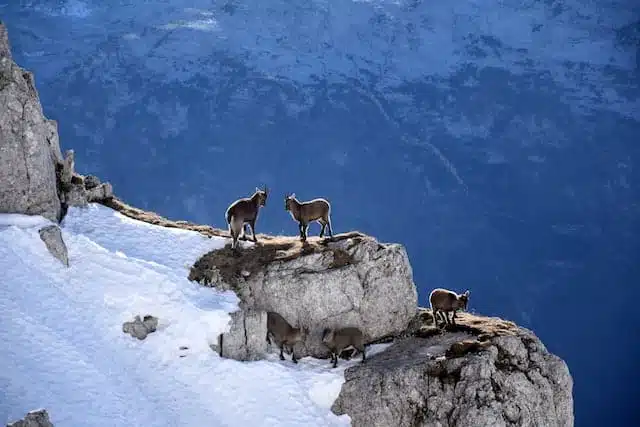The Alpine goat inhabits great altitudes and can gracefully jump around steep mountain slopes. Continue reading to discover more about this adorable hoofed animal!
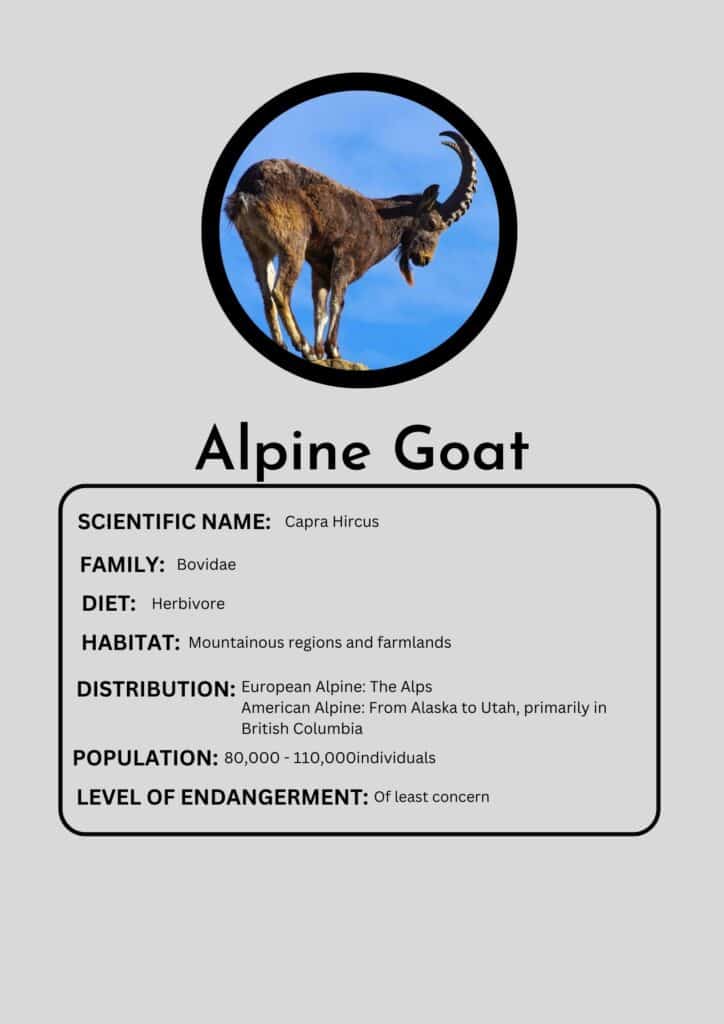
Appearance
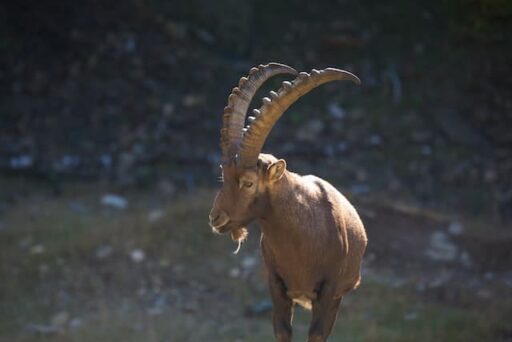
As one would guess, the Alpine Goat forms part of the goat family; Capra Hircus. There are various types of Alpine Goats. The Purebred Alpines is the “original” Alpine Goat, which as the name indicates, originated in the French Alps.
In 1922 they were introduced on the other side of the Atlantic Ocean, thus producing the American Alpine. Likewise, the French Alpines were crossbred with English mountain goats, giving rise to the British Alpine Goat.
Compared to other types of goats they are on the heavier side. Males measure 31 inches (81 cm) at the shoulders and females 30 inches (76 cm). When fully matured, males typically weigh 170 lbs (77 kg) and females 135 lbs (61 kg). Moreover, the females have large and distinct udders, indicative of their praised milk production.
Moreover, both sexes have curved horns which are fairly large in size. Other than being used in fights to display dominance between males, the horns’ primary function is to regulate their body temperature.
Consequently, goat breeders are strongly advised against removing goats’ horns, as this could cause overheating, and in severe cases lead to death.
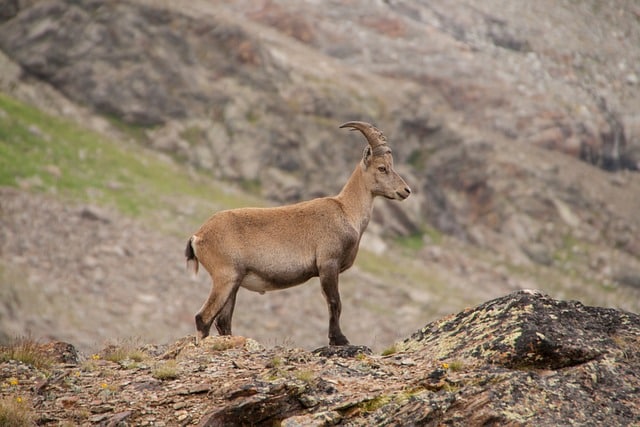
They have a straight snout and are the only members of the goat family with erect ears. Its smooth and shiny fur coat consists of short hairs and comes in an extensive variety of colors and color combinations. They have cute little tails and both sexes have a scruffy beards framing their face.
Their wide assortment of coat colors all have specific names which describe the combinations in extensive detail. For example, a “cou blanc” goat has white front legs and black hindlegs, with gray markings on the head. Other color names include cou clair, pied, chamoisee, broken chamoisee – among many others.
Habitat and Distribution
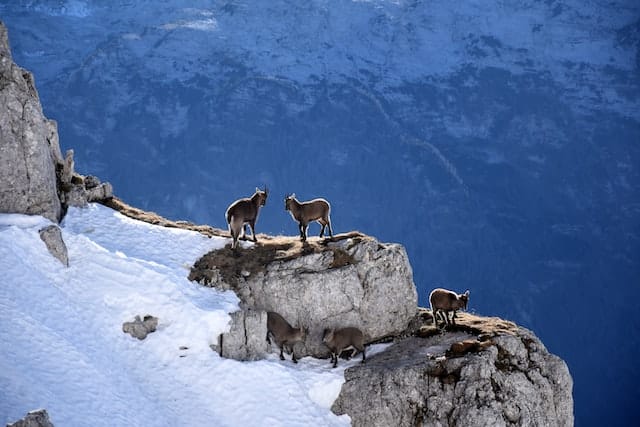
The European Alpine goat resides throughout the mountain ranges of the Alps. In other words, they primarily inhabit the countries of France, Switzerland, and Germany.
In North America, their range stretches from Alaska to Utah. However, the prevalence of the American Alpines is highest in British Columbia. Additionally, the Alpine Goat is one of the most farmed animals all around the globe.
Globally, the estimated total population of Alpine Goats is between 80,000 – 110,00 mature adults. Essentially half of the total population resides in British Columbia, which is home to roughly 50,000 goats.
Alpine goats constitute altitude migrants. This means that they migrate fairly short distances, constantly moving between higher altitudes and lower altitudes. They are able to do this due to their fabulous agility, alongside other adaptations that have evolved over centuries.
Having spent thousands of years in the steep and rocky landscapes of the Alps, naturally, the Alpine goat has developed an unmatchable balance.
Their great sense of balance assists them during their treks across the rigid and steep mountainous landscapes they inhabit. However, due to their agility, they may frustrate farmers at times as they can easily jump fences.
They are highly adaptable animals and are able to not only survive but truly thrive, in essentially any type of climate. Along with their excellent milk production, this is what has made them so versatile to humans.
Allegedly, the Alpine Goat was the very first creature that humans domesticated. Findings of goat skeletons alongside human skeletons in caves prove this. Moreover, similar archeological findings indicate a mended goat bone – and such mending could only have happened due to human interference.
Diet
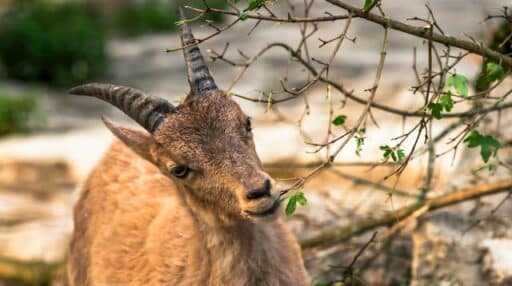
Alpine goats strictly follow a herbivorous diet. More specifically, they are graminivore creatures. This means that they almost exclusively feed through grazing.
Since the majority of their diet consists of grass and other plant materials their digestive systems are equipped with enzymes that specialize in breaking down cellulose – one of the primary components of any plant matter.
An Alpine goat living on a farm will also happily munch on hay. A lactating female will need to eat much larger amounts than other goats, typically averaging 3,5 lbs (1,5 kg) of hay or grass per day – but sometimes even more than this.
Mating and Life Cycle
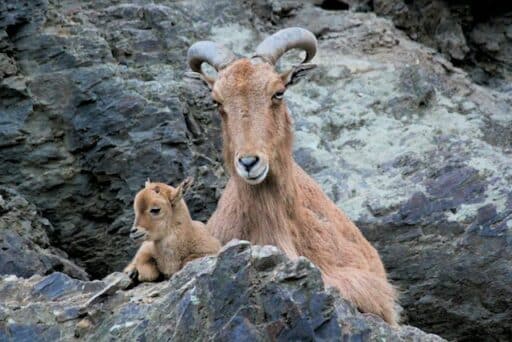
The breeding season of the Alpine Goat typically stretches from late summer to early winter (in the northern hemisphere). During the breeding season, the bucks will produce a musky odor, an odor that is fairly repugnant to humans but allows them to attract the opposite sex.
Male Alpine Goats reach sexual maturity already at 4 – 8 months old, and females slightly later, between 7 – 9 months old.
Their gestation period lasts 150 days – roughly 5 months. It is most common for a doe to give birth to twins. However, a single baby or triplets are not that rare. From time to time even quadruplets are born.
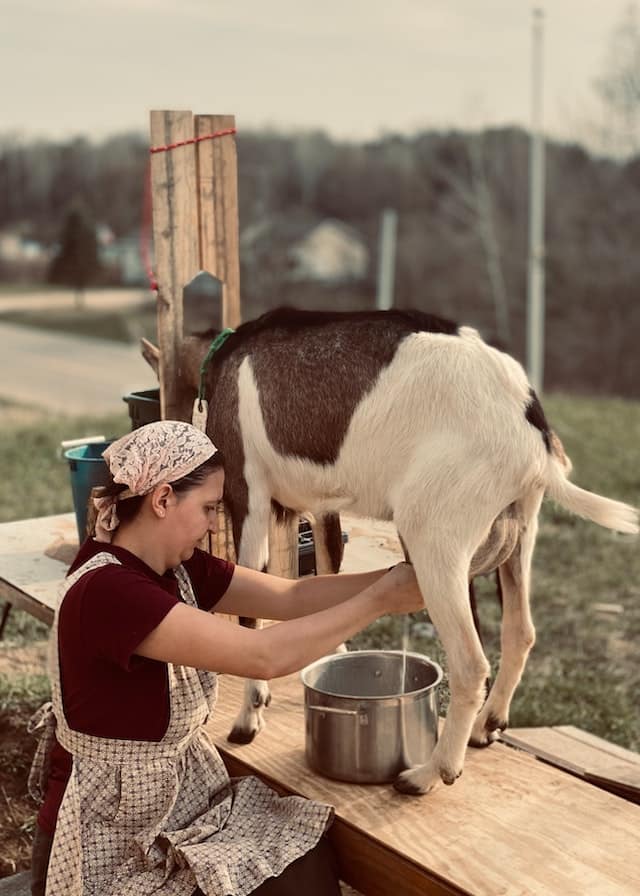
Following breeding the doe lactates for 250 – 280 days. It is their excellent milk production that the Alpine goat is famous for, and the primary reason why the species was domesticated over 9000 years ago. During lactation, the doe produces up to one gallon (3,8 liters) of milk each day – which is a very large amount considering its fairly small size.
Fun Facts – That We Bet You Didn’t Know
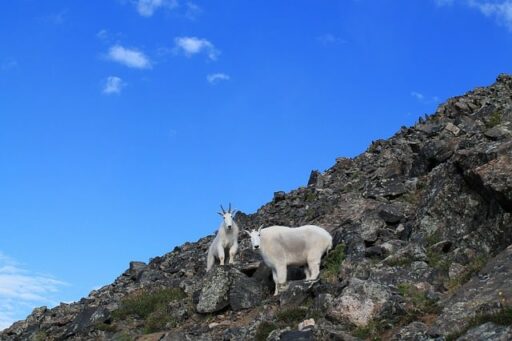
#1 Fun Fact
Much like trees, an Alpine goat’s horns form an “age ring” each year. This allows breeders to determine their age simply by investigating their horns, they will always have one ring less than their age.
#2 Fun Fact
Alpine goats are not only extremely adorable and likable animals, they can also assist in the social welfare of a community. Farming of Alpine goats provides employment opportunities in rural areas. Moreover, their milk is a great source of nutrition for impoverished people due to its high protein and sugar content.
#3 Fun Fact
The Alpine goat’s intelligence is often overlooked. Like dogs, they are able to learn their names and can respond when called.
FAQ
Their hooves are perfectly designed to make them great climbers. Firstly, the hooves are divided into two parts, allowing better grip on rocks. Likewise they are coated with a rubbery texture which prevents them from slipping.
Alpine goats venture up to risky heights in search of their favorite foods. They also crave salt, which they obtain by licking certain rocks that they can find at higher altitudes.
Alpine goats are not huge eaters. On average they only need to consume about 5 – 7% of their body weight. When female goats lactate, farmers tend to feed them more in order to accelerate their milk production.
Thank you for reading this article! Read our post about the Giant Anteater to continue learning about other interesting species.
Join our Forum for free today!


